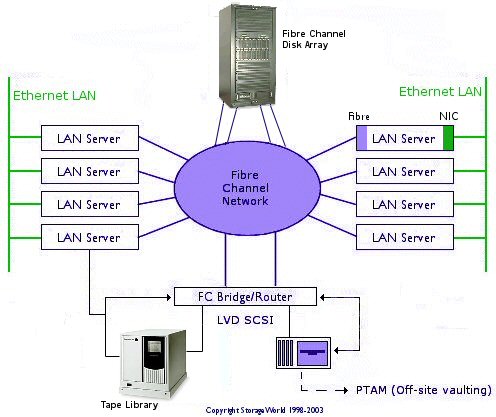|
|
|

| Overview
| Topology | Switches
Vs Hubs | LAN-Free Backup
| Serverless Backup |
|
Overview
of the SAN Environment
Conceptually,
a SAN is a high-speed network dedicated to information
management. In application, a SAN is a combination of
technologies, including hardware, software and networking
components, that provides any-to-any interconnection
of server and storage elements.
Each
SAN implementation is therefore designed specifically
for the business requirements of the client using it,
using a selection of components sourced from different
vendors or manufacturers. The design of a SAN is dependent
upon the business and technical requirements of the
client.
SANs
provide high speed data transfers between servers and
storage devices in the following three ways:
-
Server to Storage: This is the traditional
model of interaction with storage devices. The advantage
is that multiple servers may access the same storage
device serially or concurrently.
- Server
to Server: A SAN may be used for high-speed, high-volume
communications between servers, providing a practical
infrastructure for the consideration of technologies
such as server clustering, mirroring, or load balancing.
- Storage
to Storage:
SANs allow data to be moved without server intervention,
freeing up server processor cycles for other activities
like application processing. Some examples of this
communication include a disk device backing up its
data to a tape device without server intervention,
or remote device mirroring across the SAN.
|
|
Basic
SAN Structure
a very simplistic storage network

In
the above example, all the servers and storage devices
are capable of communicating and transferring data between
themselves directly via the storage network, and do
not need to consume LAN bandwidth. Using LAN-Free and
Serverless Backup provides an extremely fast, reliable,
automated backup system that can be managed by appropriate
storage management software by Tivoli,
Legato
etc.
|
| |
| The
actual design of the SAN in the centre can be formed from
several models using a selection of switches and hubs.
Topologies and designs will vary from implementation,
but may include cascade, loop, mesh, core/edge designs,
each offering varying degrees of availability and cost. |
| |
|
High
Availability (HA)
To provide a truly robust HA system, continuous access
to the data storage system must be provided. In a high
availability design, uninterrupted access to all connected
nodes are a primary objective. To achieve this, multiple
SAN connections need to be incorporated to provide alternate
network paths, eliminating any potential SPOF (single
points of failure). Duplication or mirroring of key
SAN components such as switches and cabling is necessary
in a HA design.
|
|
|
|
|